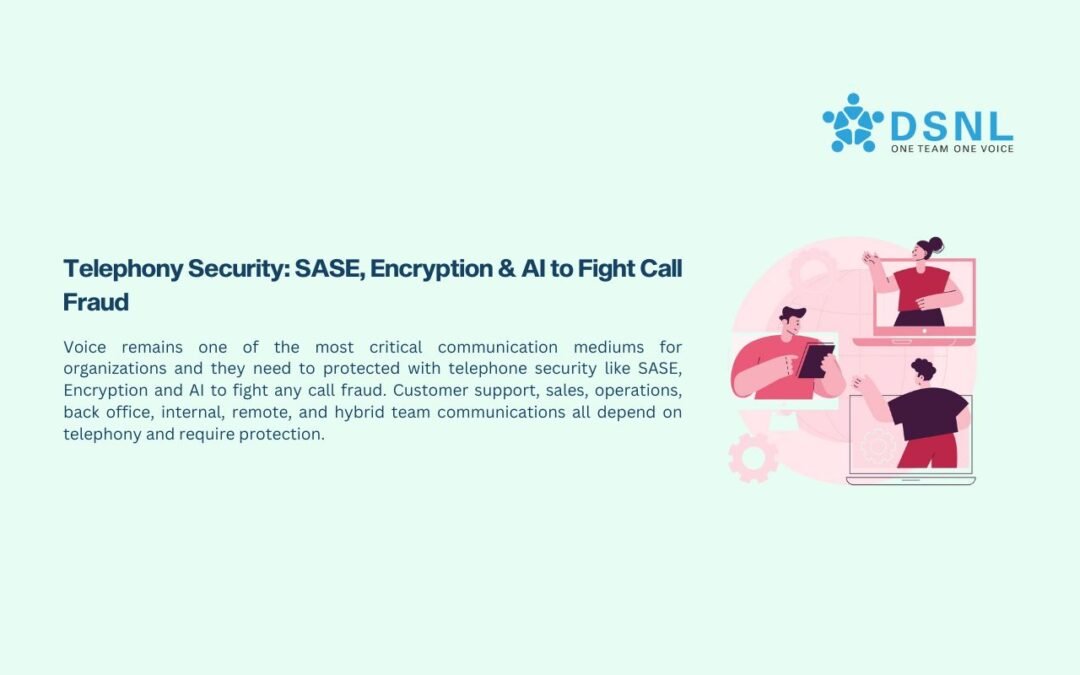Voice remains one of the most critical communication mediums for organizations and they need to protected with telephone security like SASE, Encryption and AI to fight any call fraud. Customer support, sales, operations, back office, internal, remote, and hybrid team communications all depend on telephony and require protection. Calls are used for processing sales transactions, ordering products, delivering customer service, team coordination, and project management. With the increased digitization and cloud-based transformation of legacy voice solutions, enterprises are becoming more susceptible to call fraud, toll fraud, breaches, and attacks.
Protecting Voice Networks with a SASE Architecture
Secure Access Service Edge (SASE) is a new cloud-native networking architecture designed to deliver high-performance WAN connections, security features, and cloud-based computing resources all in one platform. Organizations first adopted the SASE architecture to secure data and applications across their digital infrastructure. Enterprises can also extend SASE security to their telephony and voice communication platforms.
A SASE architecture can serve as a security perimeter for PBX systems in the cloud, secure internet protocol (SIP) trunks, and unified communication platforms and software such as UCaaS. They work by providing real-time inspection and enforcement of security policies and access controls for voice communications traffic. They can also be applied consistently across all endpoints, including desktop computers, laptops, home office systems, and mobile devices.
The SASE system can ensure that calls can only be made from an authorized user’s device, and can only be received from approved or known sources. This ensures a level of trust and policy consistency that many enterprises are unable to achieve with traditional systems, especially with unmanaged endpoints.
The SASE perimeter provides a secure connection, so that business calls and voice traffic are protected across all locations, networks, and remote access situations.
AI for Call Fraud Detection and Prevention
AI is one of the newest innovations that is becoming essential in telephony fraud and abuse prevention. AI models are capable of processing huge amounts of traffic, behavior, and usage analytics in real time to detect anomalies or risky behaviors. It’s not limited to just standard threat signatures or application rules; instead, AI models can spot abnormalities based on what’s normal for a business.
Abnormal behavior can include calls that last longer than expected, repeated access attempts, foreign calls in off-hours, a spike in outbound calling, and other variations that can signal a threat. A risk detection system equipped with AI can flag or block calls once a threshold or criteria for abnormal behavior is met. For enterprises, the advantage of using AI models is the predictive analytics capability. Machine learning helps the models to improve as it analyzes behavior and learn what is normal.
Threat Visibility and Detection
Today, threat monitoring is an important part of a voice security program. Security operations tools for threat visibility usually feature a centralized dashboard that displays the health and status of the voice network. Administrators can view access attempts, have the ability to block or trigger alerts for certain high-risk call patterns, and have real-time visibility into an entire telephony ecosystem.
Call fraud detection and incident response can also be enabled by integrating threat monitoring with voice analytics and call logs for forensics and investigations. When there is an issue with a call, it’s much easier to trace back to the originating endpoint and user ID for analysis. In the same way, the system’s dashboard and reporting features are essential for providing an audit trail for compliance reporting and record keeping.
Conclusion
The move to hybrid work has only increased the need for more sophisticated and high-performing telephony solutions. Businesses must now adopt new security solutions such as SASE, voice call encryption, and AI for next-generation telephony security.
Contact us to learn more about protecting business voice networks and why an integrated solution is key. Talk to one of our voice security and communications experts to learn more.

